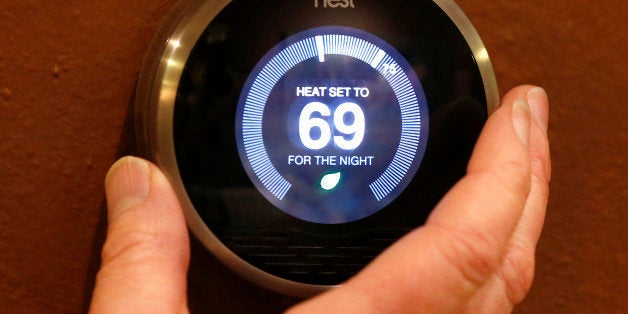
The All Writs Act, a United States federal law from 1789, broadly allows the U.S. government to issue formal orders in situations of last resort. Recently, this law has been applied to Apple on behalf of the FBI, attempting to compel the company to unlock the iPhone of the San Bernardino shooter. There is a good argument for doing this, considering he may be tied to international terrorism. Unlocking his phone could uncover similar plots. There is however, a flipside. As our environment becomes ever more connected to the internet, and the Internet of Things infiltrates our domestic sphere (and perhaps soon our bodies), we are seeing a fundamental shift in the control of our data as our few remaining barriers of privacy crumble.
When in 1982, a soft drinks vending machine at Carnegie Mellon University was the first device to be connected to a computer network, it was able to report on the amount and temperature of its contents. Today, thanks to the miniaturization of microprocessors, connected devices are able to anticipate and cater to our every need. It is no surprise that we now turn to them in our most private circumstances: the convenience of our home. By far, connected consumer devices for domestic use make up the largest market for 'smart' industry.
Nest Labs, owned by Google, markets their Learning Thermostat, which allows users to remotely control the temperature in their homes from their smartphones. The thermostat learns to anticipate its users' patterns, so it can eventually regulate the temperature on their behalf. Future-Shape, a German company pursuing large-area contactless sensor systems, has developed a textile floor surface with 32 sensors per square meter, which tracks movement to switch on the lights and open doors for us. TOTO, a Japanese manufacturer specialized in bathroom technology, has launched the Intelligence Toilet II, featuring a urine sample catcher that measures glucose levels, urine temperature, and hormone levels, using the data to regularly transmit a health report to your computer (and anywhere else) via WIFI. Samsung has revealed a transparent touchscreen at the International Consumer Electronics Show to replace window glass, which they claim will be available within ten years. And so on.
The amount of smart technologies that can be integrated into our home seems endless. In 2015, British Gas announced a range of smart home products designed by Yves Behar, who said: "In the future, everything will be smart, connected and make my life easier in some way. More importantly, the technology is invisible - I never have to pull out my phone, hide my face in a screen even push a button, for the product to work. I think this is the shape of things to come: invisible design, where things magically happen around me..."
The alarming, but also interesting thing in all of these developments is the displacement of control. In each case -- the thermostat, the toilet, the floor, the window, and on a larger scale also the traffic and weather sensors in our smart cities -- the devices are designed to both react to and trigger changes in circumstances. In doing that, these devices introduce a fundamental ambiguity who is in charge. They analyze our behavior over a longer period of time, which they then transform into an automated pattern that regulates the world around us, until eventually this world, continuously doctored and perfected, fits us like a glove. The patterns we leave, however incidental or random, become automated, eternal. They are our new truths. (Is it a coincidence that there is an acute resemblance between smart city marketing speak and biblical language?) The more these patterns are engrained, the more they become a straightjacket. Our unique identity, our behavioral DNA, becomes a form of solitary confinement from which there is no escape.
Thus far, the exchange of data in the Smart Architecture realm is primarily between humans and their objects. Various 'smart' utensils collect information on our behaviour and relay that information back to us so that we can monitor and potentially modify our behaviour. In the near future however, that pivotal position of humans in the exchange of information is by no means a given. The theoretical incorporation of all devices, institutional as well as private, into the Internet of Everything, will also permit the exchange of data between objects themselves. Through ever more sophisticated artificial intelligence, the various artefacts in our lives will interact with their environment and one another in an increasingly autonomous manner. Objects will directly transmit information to other objects, without the intercession of humans. Our devices will independently act on whatever information is available at any given moment.
In the 1970s Peter Eisenman designed a series of houses as a demonstration of the autonomous logic of (architectural) form over function -- of the inescapable apartness between man and object. Eisenman provocatively referred to the inhabitants of his house as intruders to emphasize the feeling of estrangement that ensued from architecture's liberation from its prior anthropocentrism. Forty years later, the smart house takes that notion to a new level. As the elements of our home increasingly acquire lives of their own, we become the estranged visitors in the world we have so perfectly created around us. In that sense, smart technology makes us all intruders.
The rise of smart devices, and the vast amounts of data which are being gathered and processed from individuals, have already raised concerns. America's National Security Agency (NSA) and UK's Government Communication Headquarters (GCHQ), among a dozen other national governmental bodies and agencies, were embroiled in the mass surveillance scandal revealed to the world in 2013 by Edward Snowden. In this instance, data was indiscriminately gathered under the guise of national security.
Smart buildings, and smart devices embedded in their elements, could provide an endless stream of data for governments and corporations to use, effectively monitoring the most minute aspects of people's lives, and over time learning about each individual's habits. In 2013, Silicon Valley entrepreneur Tom Coates connected his home's smart devices to Twitter. House of Coates (@houseofcoates) reports its everyday activities: "Someone just activated the Sitting Room Sensor so I'm pretty sure someone's at home" and "Looks like Tom's gone out. I saw him check in at Four Barrel Coffee." (This is remarkable, if only for its incredible banality.)
Smart devices need not be under a malicious cyber-attack, but could be quietly mined for information either by corporate or governmental interests using built-in "back doors". For instance, European lawmakers have already considered requiring all cars in their market to include a mechanism that would allow the police to stop it at any given time. In 2014, Jim Farley, a senior executive at Ford said: "We know everyone who breaks the law, we know when you're doing it. We have GPS in your car, so we know what you're doing. By the way, we don't supply that data to anyone."
But even with back doors supposedly secured -- apparently in the Apple case, the code to unlock the iPhone does not even exist -- potential hacking of the connected environment poses a major security threat. Today, when the average consumer database is hacked, the worst possible outcome is a loss of money and dignity. In the future, on an individual level, implanted medical devices could be caused to malfunction, and smart buildings, for all their intelligence, could become vulnerable to sabotage.
In 2014, a University of Michigan researcher was able to gain control of nearly 100 wirelessly networked traffic lights. As early as 2011, security researcher Jay Radcliffe demonstrated that an automatic insulin pump often used by diabetics could be hacked and its function ceased. Economist magazine raised a similar concern for our dwellings in 2014: what if boilers could be hacked and made to explode? As security expert Joshua Corman said: "If my PC is hit by a cyber-attack, it is a nuisance; if my car is attacked; it could kill me." In the short run, government intrusion into our personal data may seem to have certain benefits. However, these benefits pale into insignificance compared to the damage which could be caused by those with more nefarious goals.
